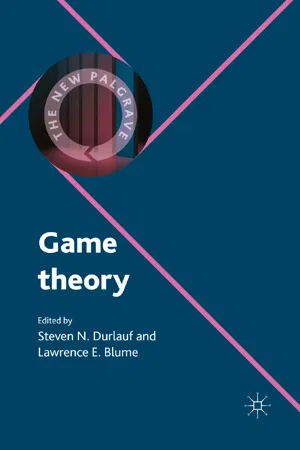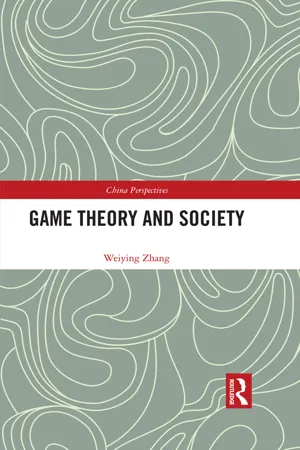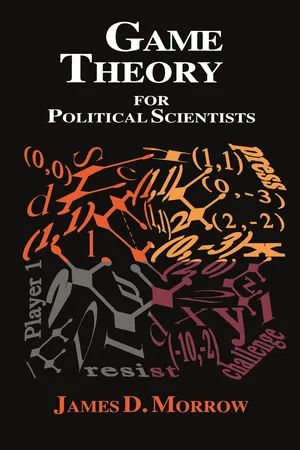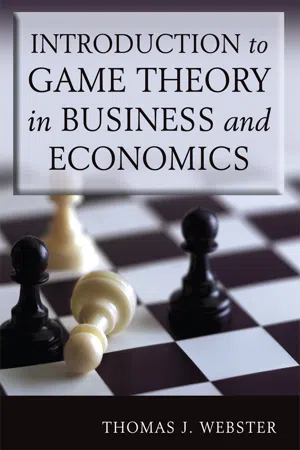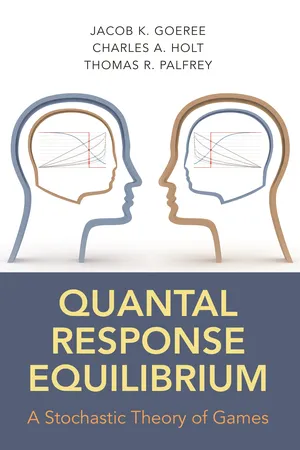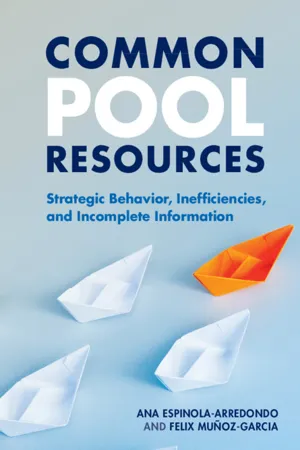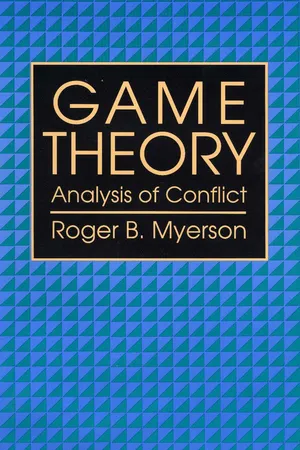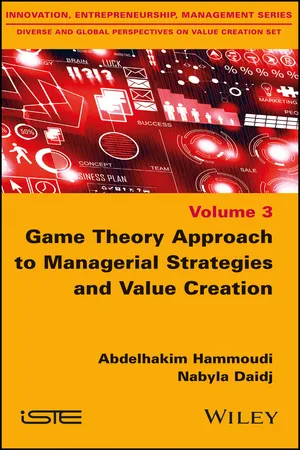Business
Infinitely Repeated Games
Infinitely repeated games refer to strategic interactions that occur repeatedly over time, with no predetermined endpoint. In this context, businesses engage in ongoing interactions with competitors, suppliers, and customers. The concept allows for the analysis of long-term strategies, the potential for cooperation and collusion, and the impact of reputation and trust in sustaining relationships over time.
Written by Perlego with AI-assistance
Related key terms
1 of 5
11 Key excerpts on "Infinitely Repeated Games"
- eBook - PDF
- Steven N. Durlauf, Lawrence E. Blume, Steven Durlauf(Authors)
- 2016(Publication Date)
- Palgrave Macmillan(Publisher)
repeated games Repeated games provide a formal and quite general framework to examine why self- interested agents manage to cooperate in a long-term relationship. Formally, repeated games refer to a class of models where the same set of agents repeatedly play the same game, called the ‘stage game’, over a long (typically, infinite) time horizon. In contrast to the situation where agents interact only once, any mutually beneficial outcome can be sustained as an equilibrium when agents interact repeatedly and frequently. A formal statement of this fact is known as the folk theorem. Repeated games and the general theories of efficiency Thanks to the developments since the mid-1970s, economics now recognizes three general ways to achieve efficiency: (a) competition; (b) contracts; and (c) long-term relationships. For standardized goods and services, with a large number of potential buyers and sellers, promoting market competition is an effective way to achieve efficiency. This is formulated as the classic First and Second Welfare Theorems in general equilibrium theory. There are, however, other important resource allocation problems which do not involve standardized goods and services. Resource allocation within a firm or an organization is a prime example, as pointed out by Ronald Coase (1937), and examples abound in social and political interactions. In such cases, aligning individual incentives with social goals is essential for efficiency, and this can be achieved by means of incentive schemes (penalties or rewards). The incentive schemes, in turn, can be provided in two distinct ways: by a formal contract or by a long-term relationship. The penalties and rewards specified by a formal contract are enforced by the court, while in a long-term relationship the value of future interaction serves as the reward and penalty to discipline the agents’ current behaviour. - eBook - ePub
- Weiying Zhang(Author)
- 2017(Publication Date)
- Taylor & Francis(Publisher)
The first choice will not influence the second choice. Of course, in reality this characteristic of repeated games cannot be strictly maintained. For example, repeated games exist between firms and customers, but the products produced by the firm and customer preferences will frequently change. Repeated games exist between China and the United States, but their internal structures and relative status in international relations are different at different times. However, “Tianji’s Horse Race” 3 is not a repeated game, because the horses chosen by Tianji and the King of Qi in the first round could not be used in the second round, so the choices in the first stage will influence the choices in the next round. Of course, if Tianji and the King of Qi are willing, they could hold a second horse race, which would be a repeated game. Second, each player can observe the game’s history or the things that happened in the previous stage games. For example, each player’s choice to cheat or be honest or cooperate or not cooperate in previous games is observable. 4 Third, each player cares for the total payoff which is the discounted value of payoff flow over all stage games. The significance of this is that because the game repeats multiple times, players do not only care about the current stage’s gains, but also gains in the future. This point causes them to have an incentive to choose differently than in one-time games. Repeated games are separated into finitely repeated games and Infinitely Repeated Games. So-called “finitely repeated games” refer to games that end after a certain time or number of occurrences, after which the related parties do not again engage in the same game. So-called “Infinitely Repeated Games” refer to games that will continue forever - eBook - PDF
- James D. Morrow(Author)
- 2020(Publication Date)
- Princeton University Press(Publisher)
For ex-ample, compare the strategy set of a two-by-two game to that of the same game repeated twice. Each player possesses only two pure strategies in the two-by-two game played once. Playing that game twice increases each player's strat-egy set to thirty-two pure strategies. A complete pure strategy specifies a move in the first round and a move in the second round for each of the four combi-nations of moves that the players could make in the first round. There are two choices in each case, for a total of 2 5 = 32. Adding a third round of the game increases the number of pure strategies to 2 21 , or 2,097,142. The strategy set of an indefinitely iterated game is infinite because there is not a fixed number of rounds of the game. We can often summarize strategies of repeated games with an indefinite end because many such strategies can be characterized by simple decision rules. These strategies often form equilibria, and as such are the center of analysis of repeated games. Repeated games also allow us to analyze situations where the payoffs from current actions lie in future benefits. For example, voters cast their votes on the basis of the policies the candidates will deliver in the future. Their current choices are based on an expectation of candidates' future behavior. Officehold-ers select policies based in part on the effect of those policies in the next elec-tion. A repeated game allows us to analyze this interaction between the voters' choices and the policies candidates adopt in office. The players do not use the repeated nature to police an agreement here. This logic differs from reciprocal punishment. Rather, their payoffs are received in future plays of the game. So their choices are based on their expectations of the future of the interaction. Both reciprocal punishments and future judgments require the players to hold expectations across an indefinite future. - Thomas J. Webster(Author)
- 2018(Publication Date)
- Routledge(Publisher)
Finitely repeated games may have a certain or an uncertain end. The P&G/Unilever relationship is an example of an infinitely repeated game, or at least a re-peated game in which the end in unknown. While this informal relationship appears to be stable, other collusive arrangements, such as the Organization of Petroleum Exporting Countries (OPEC), have been subject to frequent breakdowns. What accounts for these differences? As we will see, the nature of the relationship between the players and inherent centrifugal economic forces are central to our understanding of the fragility or durability of cooperative business relationships. CASE STUDY 4.1: EXTRA-CREDIT GAME PART I 1 To illustrate the fragile nature of cooperation in a one-time, static game, consider the results of an experiment that was conducted by the author involving twenty-nine MBA students enrolled in a managerial economics class. The experiment was conducted during three class meetings over a three-week period. The experiment involved five rounds. The first two rounds were conducted in the first week, the third and fourth rounds were conducted in the second week, and the final round in the third week. Only the first two rounds of this experiment will be discussed in this case study. A discussion of the final three rounds will be deferred until Chapter 5. The basic rules of the game were the same in each round of the experiment. Each student was instructed to write his or her name on a 3” × 5” index card. They were then asked to select from two colors ( orange or blue ), record their choice on the index card, and keep the card secret from the other students. After the students recorded their selections, the index cards were collected by the author, the colors tallied, and the results announced. The 88 CHAPTER 4 students’ identities and choice of strategies were known only to the author.- eBook - PDF
Quantal Response Equilibrium
A Stochastic Theory of Games
- Jacob K. Goeree, Charles A. Holt, Thomas R. Palfrey, Charles Holt(Authors)
- 2016(Publication Date)
- Princeton University Press(Publisher)
5.1 QRE IN Infinitely Repeated Games Repeated games are applied widely in the social sciences, often as a workhorse model of the possibility of enduring relationships to support cooperative behavior that would not be possible in a one-shot game. Finitely repeated games are a special case of extensive-form games for which the AQRE model was fully developed earlier in this book. Infinitely Repeated Games are another story, and 114 CHAPTER 5 Table 5.1. A prisoner’s dilemma game. D C D 4 , 4 10 , 2 C 2 , 10 8 , 8 the purpose of this section is to show how QRE can be extended to analyze such “supergames.” Before proceeding with the formal development of QRE for supergames, we offer the following rationale for why QRE may offer new insights into the structure of equilibria, and the stability of equilibria for these games. Example 5.1 (Repeated prisoner’s dilemma game) : Consider the prisoner’s dilemma stage game in table 5.1. In this game, the unique Nash equilibrium is ( D , D ). Also, it is well known that in any finitely repeated game with T repetitions, playing ( D , D ) in every history is the only subgame-perfect equilibrium of the game. However, if the game is infinitely repeated and if players are sufficiently patient, then there exist many subgame-perfect Nash equilibria whose equilibrium paths involve players choosing ( C , C ) in every period. Such equilibria are supported by strategies that ensure lower long-run payoffs off the equilibrium path. There are at least two conceptual problems with this. First, if there is any noise in the play (as there would be in an experiment or in most other applications), then play will certainly fail to be on the equilibrium path at some point. One then must face the question about whether the specified strategies off the path are plausible. There are many reasons why they might not be. In particular, there is an extensive literature on renegotiation-proofness requirements for off-path strategies. - eBook - ePub
Game Theory
A Modeling Approach
- Richard Alan Gillman, David Housman(Authors)
- 2019(Publication Date)
- Chapman and Hall/CRC(Publisher)
Chapter 7Repetitious PlayThe strategic, extensive, and bargaining games we have discussed so far assume that the players’ interactions are independent of any previous or future interaction. More realistically, players interact with each other multiple times in a variety of ways, and the actions they choose in one interaction are likely to depend upon past experience and predictions about future behavior. We examine models of repetitious play and features unique to these models. In particular, we examine the multiplicity of Nash equilibria and the robustness of qualitative behavior in different models.Up to this point, we have examined various models of games that may have multiple stages but ultimately are assumed to be played once. In this chapter, we will introduce repeated play games as a new mathematical modeling tool. Mathematically, all of these models are extensive games once we resolve how the payoffs in individual games are to be combined into a payoff for the repeated game. Nonetheless, the special properties of repeated play lead to special considerations (such as errors in perception and implementation) and interesting results (such as the ubiquity of equilibria). The dynamics of strategy choice that are passed on in a species also become a focus. We begin with the simplest of repeated games.Definition 7.0.1. A finite repeated game consists of the following:1.A game G with all of its embedded players, outcomes, rules, and utilities.2.An integer m ≥ 2.3.In stage k = 1, 2, …, m , the game G is played with all players knowing the actions chosen in the previous stage.4.Utilities for each player i are defined to be the mean of the utilities player i obtained in each stage of the repeated game.A common example of a game that can be extended to a finite repeated game is the Prisoner’s Dilemma game. When the Prisoner’s Dilemma game is played only once, players choose strategies with little information about how their opponent might behave, leading them to the Nash equilibrium which is not efficient. However, if we imagine partners in crime that find themselves in this dilemma often, we can see that over time they might develop a more informed strategy because they know how their partner has behaved in the past. The Prisoner’s Dilemma is just one of many scenarios we call Social Dilemmas. - eBook - PDF
Common Pool Resources
Strategic Behavior, Inefficiencies, and Incomplete Information
- Ana Espinola-Arredondo, Felix Muñoz-Garcia(Authors)
- 2021(Publication Date)
- Cambridge University Press(Publisher)
5 Repeated Interaction in the Commons 5.1 introduction Previous chapters discussed games where firms (e.g., fishing compa- nies or farmers sharing an aquifer) interact only once. These games are also known as “one-shot games” or “unrepeated games,” and can help us model strategic settings in which players do not anticipate interacting again in future periods. In many settings, however, the same group of firms interact several times, facing the same game repeatedly. An interesting feature of repeated games is that they can help us rationalize players’ cooperation, even when such cooperation could not be sustained in the unrepeated version of the game. Section 5.2 presents a simple model of a CPR game, highlighting its similarities with the canonical prisoner’s dilemma game. This tractable model helps us in our presentation of repeated interaction in finitely repeated games (Section 5.3) or Infinitely Repeated Games (Section 5.4). Cooperative outcomes, understood as firms exploiting the resource below what they would do in an unrepeated game, cannot be sustained in the equilibrium of the finitely repeated game. Intuitively, firms anticipate that they will be appropriating as much as possible in the last period of interaction, and that such behavior will not be affected by previous history of play. In the previous- to-last period, they anticipate such exploitation in the subsequent period, which leads all firms to exploit the CPR at maximal levels on the previous-to-last period too. A similar argument extends to all previous periods until the first, implying that firms choose a high appropriation level during all periods; a big failure in our quest to use repeated games as a tool to promote cooperation in the commons! 64 - eBook - PDF
Game Theory
An Introduction
- E. N. Barron(Author)
- 2024(Publication Date)
- Wiley(Publisher)
285 5 Repeated Games The same thing happened today that happened yesterday, only to different people –Walter Winchell Change begets change as much as repetition reinforces repetition. –Bill Drayton The more often a stupidity is repeated, the more it gets the appearance of wisdom. –Friedrich Nietzsche Repetition is the mother of learning, but variation is the spice of life. –George Bernard Shaw What happens when a game is played more than once? Many real games are played over and over again, such as setting prices or production levels for each of two or more firms. Battles in a war can be considered as two game opponents fighting essentially the same battle again and again. Companies set prices on their products every day to maximize sales. There are many games played over and over again. Think of a prisoner’s dilemma game played more than once. Recall that in the prisoner’s dilemma, the course of action predicted by Nash would be to defect, i.e., to rat out the other guy. But both players would do better if they cooperated and clammed up. But what if a prisoner knew that she was going to play again; would it affect the best course of action? Is it possible that knowing a game will be played again, possibly with no end, would lead to cooperation? Would knowledge of the players of how the opponents chose to play make any difference in a prisoner’s dilemma game played more than once? To answer that, let’s consider the two-stage extensive form of the prisoner’s dilemma given in Figure 5.1. The information sets are designed so that each player knows her own moves but not that of the opponent. The one-stage game matrix is C D C (2, 2) (0, 3) D (3, 0) (1, 1) (PD) Game Theory: An Introduction, Third Edition. E. N. Barron. © 2024 John Wiley & Sons, Inc. Published 2024 by John Wiley & Sons, Inc. - eBook - ePub
Game Theory
Analysis of Conflict
- Roger B. Myerson, Roger B. Myerson(Authors)
- 2013(Publication Date)
- Harvard University Press(Publisher)
7Repeated Games
7.1 The Repeated Prisoners’ Dilemma
People may behave quite differently toward those with whom they expect to have a long-term relationship than toward those with whom they expect no future interaction. To understand how rational and intelligent behavior may be affected by the structure of a long-term relationship, we study repeated games.In a repeated game, there is an infinite sequence of rounds , or points in time, at which players may get information and choose moves. That is, a repeated game has an infinite time horizon , unlike the finite game trees that were considered in Chapter 2 . In a repeated game, because no move is necessarily the last, a player must always consider the effect that his current move might have on the moves and information of other players in the future. Such considerations may lead players to be more cooperative, or more belligerent, in a repeated game than they would be in a finite game in which they know when their relationship will end.To introduce the study of repeated games, let us begin with a well-known example, the repeated Prisoners’ Dilemma (Table 7.1 ). Heregiis i ’s generous move, andfiis i ’s selfish move. As we saw in Chapter 3 , (f 1 ,f 2 ) is the only equilibrium of this game. Now let us consider what happens if players 1 and 2 expect to repeatedly play this game with each other every day, for a long time.Table 7.1 Prisoners’ Dilemma gameFor example, suppose that the number of times that the game will be played is a random variable, unknown to the players until the game stops, and that this random stopping time is a geometric distribution with expected value 100. That is, the probability of play continuing for exactly k rounds is (.99k −1) × .01. Thus, after each round of play, the probability that players 1 and 2 will meet and play again is .99; and at any time when they are still playing, the expected number of further rounds of play is 100. In this repeated game, generous behavior can be supported in equilibrium. Consider, for example, the strategy of playinggievery day until someone plays f 1 or f 2 , and thereafter playingfi - eBook - PDF
- Tatsuro Ichiishi, Abraham Neyman, Yair Tauman, Karl Shell(Authors)
- 2014(Publication Date)
- Academic Press(Publisher)
Repeated Games with Incomplete Information FRANÇOISE FORGES CORE, Université Catholique de Louvain 1. INTRODUCTION This chapter surveys recent results on Infinitely Repeated Games with incom-plete information. These are nonzero-sum games with lack of information on one side and standard signalling matrices (informing the players of each oth-ers' moves after every stage) and zero-sum games with more delicate information and signalling patterns. The motivation for games with incomplete information is clear: most interest-ing features of social and economic situations are justified by the asymmetry of the information of the individuals involved. The duration of the relationships between agents explains also many parts of behavior, like threat, punishment, reward, careful revelation of knowledge, patient gathering of information. . . . The model of repeated games was conceived to study all these aspects related to durable relationships. Under complete information, the main theme is that repe-tition enables cooperation (Folk Theorem). Under incomplete information, the repetition of the game appears also as a signalling mechanism, with all the com-plexities required by the strategic transmission of information. Infinitely Repeated Games with incomplete information were born in 1966, in a fundamental article of Aumann and Maschler. This was the first of a series of papers (reports to the U.S. Arms Control and Disarmament Agency), which constitute the basis for the theory. When I started to discover this field, about fifteen years later, a long way had already been covered. A weekly seminar was organized on the subject at Lou-vain; it started with talks of S. Hart, who presented his characterization of Nash equilibria in Infinitely Repeated Games with lack of information on one side. J. F. Mertens and A. Neyman had just completed their paper on stochastic games, S. - Abdelhakim Hammoudi, Nabyla Daidj(Authors)
- 2017(Publication Date)
- Wiley-ISTE(Publisher)
To illustrate the Trigger strategy, take the example of offsetting production quotas. If there is only one period in the game, coordination is impossible due to the prisoner’s dilemma because the best response to low production is a higher production. Imagine then that the game is repeated three times (over 3 days): the two companies agree the first day and reach a Nash equilibrium; on the second day they anticipate the results from the third day and apply the Nash equilibrium, but as there is no longer any continuity to the game, one of them will betray the other on the third day. We can therefore conclude that coordination is not possible. At all points, there is a Nash equilibrium because the two players are aware that the game has an end. For the coordination to function, the game must be infinite. The players “discipline” themselves when there is a sanction the next day. In other words, the players must not know that the game is based on a finite number of games. As was mentioned earlier, the outcomes are different in the case of a number of infinite periods. As soon as a firm does not affect a probability 1 (certain event) at the end of its exercise on the market, it functions as if the game had an infinite horizon: the likelihood of playing the next period is never null, the firm considers that the number of its interventions is infinite.Box 2.8. Comparisons of the Tit-for-Tat and Trigger strategies (adapted from [SHO 06])
Tit-for-Tat Trigger strategy - - cooperation in the case where the other player cooperates with the previous periods
- - betrayal in the case where the other player betrays the previous period
Cooperation until the other player betraysIn case of deviation, the players behave non-cooperatively the remainder of the game. Tit-for-Tat Trigger strategy - - more indulgent
- - forgets easily
- - proportional
- - credible but lacks in dissuasion
- - less indulgent
- - doesn’t forget
- - “extreme”
- - adequate dissuasion but lacks credibility
“Is cooperation easy?” “Is cooperation possible?” Box 2.9. Trigger strategy and sustainability of an indefinitely repeated game
As we have already highlighted previously, the efficiency of the Trigger strategy for sustaining cooperation in a repeated game is not always guaranteed. It is subordinate to another characteristic: the more or less substantial monetary depreciation (w
Index pages curate the most relevant extracts from our library of academic textbooks. They’ve been created using an in-house natural language model (NLM), each adding context and meaning to key research topics.
